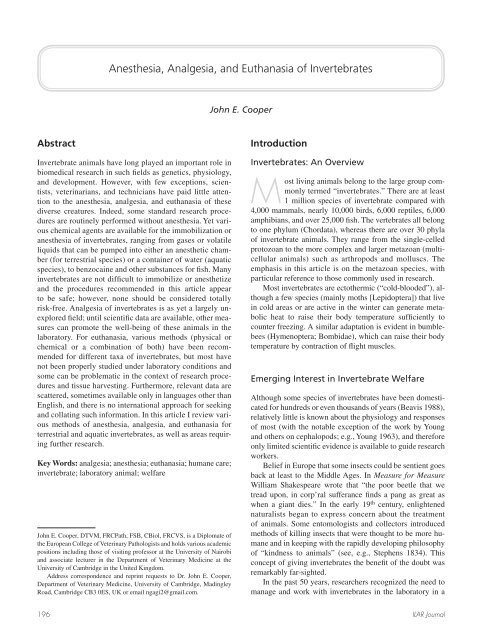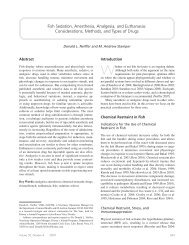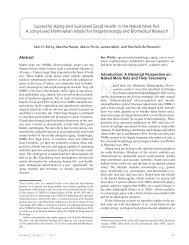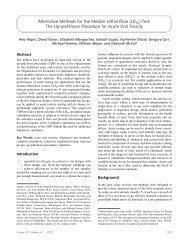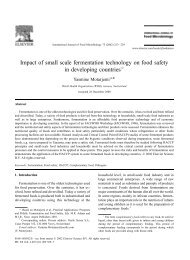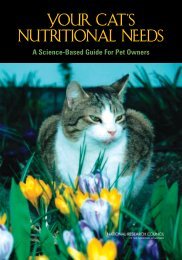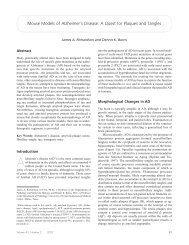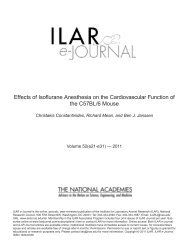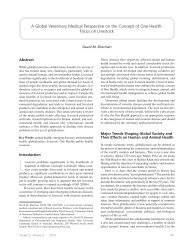Anesthesia, Analgesia, and Euthanasia of Invertebrates
Anesthesia, Analgesia, and Euthanasia of Invertebrates
Anesthesia, Analgesia, and Euthanasia of Invertebrates
You also want an ePaper? Increase the reach of your titles
YUMPU automatically turns print PDFs into web optimized ePapers that Google loves.
Abstract<br />
<strong>Anesthesia</strong>, <strong>Analgesia</strong>, <strong>and</strong> <strong>Euthanasia</strong> <strong>of</strong> <strong>Invertebrates</strong><br />
Invertebrate animals have long played an important role in<br />
biomedical research in such fi elds as genetics, physiology,<br />
<strong>and</strong> development. However, with few exceptions, scientists,<br />
veterinarians, <strong>and</strong> technicians have paid little attention<br />
to the anesthesia, analgesia, <strong>and</strong> euthanasia <strong>of</strong> these<br />
diverse creatures. Indeed, some st<strong>and</strong>ard research procedures<br />
are routinely performed without anesthesia. Yet various<br />
chemical agents are available for the immobilization or<br />
anesthesia <strong>of</strong> invertebrates, ranging from gases or volatile<br />
liquids that can be pumped into either an anesthetic chamber<br />
(for terrestrial species) or a container <strong>of</strong> water (aquatic<br />
species), to benzocaine <strong>and</strong> other substances for fi sh. Many<br />
invertebrates are not diffi cult to immobilize or anesthetize<br />
<strong>and</strong> the procedures recommended in this article appear<br />
to be safe; however, none should be considered totally<br />
risk-free. <strong>Analgesia</strong> <strong>of</strong> invertebrates is as yet a largely unexplored<br />
fi eld; until scientifi c data are available, other measures<br />
can promote the well-being <strong>of</strong> these animals in the<br />
laboratory. For euthanasia, various methods (physical or<br />
chemical or a combination <strong>of</strong> both) have been recommended<br />
for different taxa <strong>of</strong> invertebrates, but most have<br />
not been properly studied under laboratory conditions <strong>and</strong><br />
some can be problematic in the context <strong>of</strong> research procedures<br />
<strong>and</strong> tissue harvesting. Furthermore, relevant data are<br />
scattered, sometimes available only in languages other than<br />
English, <strong>and</strong> there is no international approach for seeking<br />
<strong>and</strong> collating such information. In this article I review various<br />
methods <strong>of</strong> anesthesia, analgesia, <strong>and</strong> euthanasia for<br />
terrestrial <strong>and</strong> aquatic invertebrates, as well as areas requiring<br />
further research.<br />
Key Words: analgesia; anesthesia; euthanasia; humane care;<br />
invertebrate; laboratory animal; welfare<br />
John E. Cooper, DTVM, FRCPath, FSB, CBiol, FRCVS, is a Diplomate <strong>of</strong><br />
the European College <strong>of</strong> Veterinary Pathologists <strong>and</strong> holds various academic<br />
positions including those <strong>of</strong> visiting pr<strong>of</strong>essor at the University <strong>of</strong> Nairobi<br />
<strong>and</strong> associate lecturer in the Department <strong>of</strong> Veterinary Medicine at the<br />
University <strong>of</strong> Cambridge in the United Kingdom.<br />
Address correspondence <strong>and</strong> reprint requests to Dr. John E. Cooper,<br />
Department <strong>of</strong> Veterinary Medicine, University <strong>of</strong> Cambridge, Madingley<br />
Road, Cambridge CB3 0ES, UK or email ngagi2@gmail.com.<br />
John E. Cooper<br />
Introduction<br />
<strong>Invertebrates</strong>: An Overview<br />
Most living animals belong to the large group commonly<br />
termed “invertebrates.” There are at least<br />
1 million species <strong>of</strong> invertebrate compared with<br />
4,000 mammals, nearly 10,000 birds, 6,000 reptiles, 6,000<br />
amphibians, <strong>and</strong> over 25,000 fi sh. The vertebrates all belong<br />
to one phylum (Chordata), whereas there are over 30 phyla<br />
<strong>of</strong> invertebrate animals. They range from the single-celled<br />
protozoan to the more complex <strong>and</strong> larger metazoan (multicellular<br />
animals) such as arthropods <strong>and</strong> molluscs. The<br />
emphasis in this article is on the metazoan species, with<br />
particular reference to those commonly used in research.<br />
Most invertebrates are ectothermic (“cold-blooded”), although<br />
a few species (mainly moths [Lepidoptera]) that live<br />
in cold areas or are active in the winter can generate metabolic<br />
heat to raise their body temperature suffi ciently to<br />
counter freezing. A similar adaptation is evident in bumblebees<br />
(Hymenoptera; Bombidae), which can raise their body<br />
temperature by contraction <strong>of</strong> fl ight muscles.<br />
Emerging Interest in Invertebrate Welfare<br />
Although some species <strong>of</strong> invertebrates have been domesticated<br />
for hundreds or even thous<strong>and</strong>s <strong>of</strong> years (Beavis 1988),<br />
relatively little is known about the physiology <strong>and</strong> responses<br />
<strong>of</strong> most (with the notable exception <strong>of</strong> the work by Young<br />
<strong>and</strong> others on cephalopods; e.g., Young 1963), <strong>and</strong> therefore<br />
only limited scientifi c evidence is available to guide research<br />
workers.<br />
Belief in Europe that some insects could be sentient goes<br />
back at least to the Middle Ages. In Measure for Measure<br />
William Shakespeare wrote that “the poor beetle that we<br />
tread upon, in corp’ral sufferance fi nds a pang as great as<br />
when a giant dies.” In the early 19 th century, enlightened<br />
naturalists began to express concern about the treatment<br />
<strong>of</strong> animals. Some entomologists <strong>and</strong> collectors introduced<br />
methods <strong>of</strong> killing insects that were thought to be more humane<br />
<strong>and</strong> in keeping with the rapidly developing philosophy<br />
<strong>of</strong> “kindness to animals” (see, e.g., Stephens 1834). This<br />
concept <strong>of</strong> giving invertebrates the benefi t <strong>of</strong> the doubt was<br />
remarkably far-sighted.<br />
In the past 50 years, researchers recognized the need to<br />
manage <strong>and</strong> work with invertebrates in the laboratory in a<br />
196 ILAR Journal
humane way. Early editions <strong>of</strong> the UFAW H<strong>and</strong>book on the<br />
Care <strong>and</strong> Management <strong>of</strong> Laboratory Animals (e.g., UFAW<br />
1967) included chapters on the fruit fl y, house fl y, <strong>and</strong> blow<br />
fl y, the American cockroach, locusts, crickets, beetles, ticks,<br />
<strong>and</strong> molluscs.<br />
Until relatively recently, however, little attention was<br />
paid to the health <strong>and</strong> welfare <strong>of</strong> invertebrates in captivity<br />
(Cooper 1980, 1987a,b; Cooper <strong>and</strong> Zwart 2005, 225-245;<br />
Frye 1986, 1990; Williams 2002). The situation is changing<br />
largely because <strong>of</strong> the importance <strong>and</strong> value <strong>of</strong> these animals<br />
when they are kept or managed in zoos, in private collections,<br />
<strong>and</strong> in conservation projects <strong>and</strong> because invertebrates<br />
play an increasingly signifi cant part in research (see below).<br />
Wilson-S<strong>and</strong>ers (2011, in this issue) illustrates the range <strong>of</strong><br />
research, testing, <strong>and</strong> educational procedures in which invertebrates<br />
are used.<br />
Nonetheless there is much debate as to whether invertebrates<br />
can feel pain, although most species show responses<br />
to adverse stimuli (Cooper 2006). Many (e.g., the cephalopods)<br />
have a well-developed nervous system, <strong>and</strong> in some<br />
species researchers have identifi ed opioid systems similar to<br />
those associated with pain sensation in mammals (Kavaliers<br />
et al. 1983). 1 Elwood (2011, in this issue) explores in detail<br />
the hypothesis that invertebrates might experience pain,<br />
carefully distinguishing such experience from pain reception<br />
(nociception).<br />
The focus <strong>of</strong> this article is the use <strong>of</strong> anesthesia, analgesia,<br />
<strong>and</strong> euthanasia in invertebrates that are kept for research.<br />
Much <strong>of</strong> the text is also pertinent to the care <strong>of</strong> these animals<br />
when they are kept in captivity for other purposes such as<br />
display, exhibition, or pleasure (Cooper 1987a, 1998; Cooper<br />
<strong>and</strong> Zwart 2005).<br />
<strong>Anesthesia</strong><br />
<strong>Anesthesia</strong> <strong>of</strong> invertebrates is necessary either (1) to immobilize<br />
an animal to facilitate examination or sampling or<br />
(2) to permit the performance <strong>of</strong> procedures (e.g., magnetic<br />
resonance imaging; Figure 1) that may be stressful or painful<br />
(in such instances it may be used in conjunction with<br />
analgesia).<br />
In the past, research scientists <strong>and</strong> others working with<br />
invertebrates tended to perform procedures without anesthesia<br />
or use only hypothermia, sometimes with little regard for<br />
the animals’ well-being. This approach is probably not conducive<br />
to good experimental technique or accurate scientifi c<br />
results. It is increasingly unacceptable to conduct invasive<br />
procedures on invertebrates without some form <strong>of</strong> chemical<br />
restraint, preferably through the use <strong>of</strong> an agent with known<br />
anesthetic properties (Cooper 2001). There may also be legal<br />
arguments for anesthetizing invertebrates when they are used<br />
1 It is interesting, <strong>and</strong> perhaps pertinent, to note that electric fences are<br />
among methods used to discourage molluscs from escaping from study<br />
enclosures <strong>and</strong> to confi ne animals to trays in helicultural enterprises<br />
(Symondson 1993).<br />
Figure 1 Magnetic resonance image <strong>of</strong> an anesthetized Achatina<br />
snail.<br />
in research; animal welfare legislation in some countries<br />
covers some or all invertebrates (ME Cooper 1987).<br />
It is important for researchers <strong>and</strong> technicians who deal<br />
with invertebrates to be familiar with <strong>and</strong> able to use appropriate<br />
anesthetic techniques for these species. The “higher”<br />
(i.e., more complex) invertebrates are generally not diffi cult<br />
to anesthetize, <strong>and</strong> most <strong>of</strong> the procedures recommended in<br />
the sections below seem to be relatively safe; indeed, some<br />
taxa, such as cockroaches, are remarkably resistant to hypoxia.<br />
However, as with other species, no method is totally<br />
risk-free <strong>and</strong> the old British maxim that “there are no safe<br />
anesthetics, only safe anesthetists” remains true, even when<br />
one is dealing with invertebrates. Particularly in this context,<br />
the scientist, technologist, or veterinarian who is familiar<br />
with biology <strong>and</strong> natural history <strong>and</strong> who underst<strong>and</strong>s the<br />
needs <strong>of</strong> the species has an advantage over the person with<br />
no such knowledge.<br />
The excellent book on invertebrate medicine edited by<br />
Lewbart (2006; the second edition is in press, Lewbart 2011)<br />
presents methods for the anesthesia <strong>of</strong> over a dozen different<br />
taxa <strong>of</strong> invertebrates. For some that have been widely used in<br />
research, such as the Nematoda (Bodri 2006), a whole range<br />
<strong>of</strong> techniques is available <strong>and</strong> there is extensive supporting<br />
literature. However, there is still, it appears, a dearth <strong>of</strong> information<br />
about the use <strong>of</strong> anesthetic agents in many groups.<br />
For example, Foster (2006, 242) stated that “there are currently<br />
no known reports <strong>of</strong> anesthesia use in chaetognaths”<br />
but, as with other such claims, it is not clear whether the<br />
statement follows a full literature search in languages other<br />
than English. Similarly, Smolowitz (2006, 74) claimed that<br />
“little work has been done to identify appropriate anesthetic<br />
agents” in gastropods <strong>and</strong> Lewbart (2006, 129) observed that<br />
“there is little in the literature on anesthesia <strong>of</strong> leeches.”<br />
Clearly, a more international approach is necessary for seeking<br />
<strong>and</strong> collating relevant information on anesthesia <strong>and</strong><br />
other topics relating to invertebrates.<br />
The following methods <strong>of</strong> chemical immobilization for<br />
terrestrial <strong>and</strong> aquatic invertebrates are recommended based<br />
largely on my experience working with various species in<br />
Volume 52, Number 2 2011 197
the laboratory, in zoological collections, <strong>and</strong> in veterinary<br />
practice. I also draw on the observations <strong>of</strong> Zwart (both cited<br />
in Fehr et al. 2005 <strong>and</strong> from personal communications).<br />
Although it is not clear whether some <strong>of</strong> the agents documented<br />
produce a true state <strong>of</strong> anesthesia or merely immobilize<br />
the animal, 2 they usually prove to be safe (in terms <strong>of</strong><br />
patient recovery), are generally well tolerated, <strong>and</strong> greatly<br />
facilitate the h<strong>and</strong>ling <strong>and</strong> manipulation <strong>of</strong> individual animals<br />
<strong>and</strong> groups.<br />
Terrestrial Species: Inhalation <strong>Anesthesia</strong><br />
Is<strong>of</strong>l urane (5–10%), sev<strong>of</strong>l urane, halothane (5–10%), or carbon<br />
dioxide (CO 2; 10–20%) are now the most commonly<br />
used agents for the anesthesia <strong>of</strong> terrestrial invertebrates.<br />
They are administered by either a jar or, more appropriately,<br />
an anesthetic chamber (Figure 2). A chamber for use with<br />
insects, arachnids, <strong>and</strong> crustaceans is available (Applebee<br />
<strong>and</strong> Cooper 1989), but such a sophisticated <strong>and</strong> relatively<br />
expensive item is not essential. Suitable chambers can be<br />
improvised from a variety <strong>of</strong> items, notably from “recycled”<br />
plastic bottles that can be disinfected or discarded after use;<br />
Pizzi (2006) describes the use <strong>of</strong> this method with spiders. It<br />
is important to place gauze or something similar over the end<br />
<strong>of</strong> the tubing in such systems because certain invertebrates<br />
may attempt to escape (Chitty 2006).<br />
Induction with an inhalation agent usually takes several<br />
minutes but can vary according to the species <strong>and</strong> the ambient<br />
temperature. Recovery can be prolonged (2–5 hours) but<br />
is usually uneventful.<br />
Many arthropod species can be anesthetized safely with<br />
inhalation agents (Figure 3) <strong>and</strong> some are remarkably tolerant<br />
to hypoxia. In one unpublished trial I exposed American cockroaches<br />
(Periplaneta americana) to 100% CO 2 for 2 hours;<br />
recovery took several hours but there were no fatalities. Cockroaches<br />
may be unusual in this respect, but I have also found<br />
the routine use <strong>of</strong> 20% CO 2 or 10% is<strong>of</strong>l urane, halothane, or<br />
sev<strong>of</strong>l urane to be successful <strong>and</strong> safe in several other species<br />
<strong>of</strong> arthropod. If a procedure is considered to be potentially<br />
painful, there may be merit in using is<strong>of</strong>l urane, halothane, or<br />
sev<strong>of</strong>l urane rather than CO 2 because the extent to which the<br />
latter induces analgesia in invertebrates is not known, <strong>and</strong> its<br />
use in vertebrate animals is controversial because <strong>of</strong> concerns<br />
about its effects on the animals’ health <strong>and</strong> welfare.<br />
Is<strong>of</strong>l urane is probably the current agent <strong>of</strong> choice for<br />
anesthetizing terrestrial invertebrates. Chitty (2006) described<br />
its use in myriapods <strong>and</strong> Pizzi (2006) in spiders, <strong>and</strong><br />
Bodri (2006) included it in his extensive formulary <strong>of</strong> anesthetic<br />
agents for nematodes.<br />
Terrestrial or amphibious molluscs are <strong>of</strong>ten best anesthetized<br />
using water-soluble agents (as discussed below).<br />
Snails <strong>and</strong> slugs can be placed foot down in a glass recepta-<br />
2 In this article the term “anesthesia” implies that an animal is rendered<br />
insensitive to noxious stimuli; “immobilization” means that the animal<br />
cannot move but may or may not be aware <strong>of</strong> such stimuli.<br />
Figure 2 An anesthetic chamber (18 cm deep × 22 cm long × 15 cm<br />
wide) suitable for terrestrial invertebrates.<br />
cle with 0.5 to 5 cm <strong>of</strong> water (depending on the animal’s<br />
size) containing the chemical.<br />
Aquatic Species<br />
Noga <strong>and</strong> colleagues (2006) provided an excellent table <strong>of</strong><br />
agents that can be effective for immobilizing/anesthetizing<br />
crustaceans <strong>and</strong> many <strong>of</strong> the agents <strong>and</strong> techniques they advocated<br />
are likely applicable to other aquatic taxa. Based on my<br />
experience, the following information applies to freshwater<br />
<strong>and</strong> marine species as well as temperate <strong>and</strong> tropical aquatic<br />
species (Figure 4). At high (tropical) temperatures, induction<br />
<strong>of</strong> <strong>and</strong> recovery from anesthesia usually occur more rapidly,<br />
in keeping with the ectothermic nature <strong>of</strong> invertebrates.<br />
Anesthetic agents are best administered to invertebrates<br />
in a specifi c container. I use a clean glass container that, depending<br />
on the size <strong>of</strong> the animal, holds between 0.5 <strong>and</strong> 5.0<br />
liters <strong>of</strong> fl uid (Figure 5). The water in the container can<br />
either be from the animal’s own tank or, preferably, made up<br />
fresh. The latter must be carefully prepared, especially for<br />
Figure 3 Inhalation methods are effective with large metazoan<br />
species, such as this anesthetized mygalomorph spider.<br />
198 ILAR Journal
Figure 4 Aquatic species, such as this cuttlefi sh (a cephalopod),<br />
need careful h<strong>and</strong>ling prior to <strong>and</strong> during anesthesia to avoid damage<br />
to delicate structures such as the mantle.<br />
marine species, for which salt concentration can be crucial.<br />
The water in the container should be at the same temperature<br />
as that from which the animal is transferred. If necessary,<br />
anesthesia can be induced in the animal’s home tank, although<br />
complications can arise with this approach if several<br />
invertebrates are present, not all <strong>of</strong> which require anesthesia,<br />
or if there is a fi ltration <strong>and</strong> water circulation system that can<br />
dilute or remove the anesthetic agent.<br />
Absorption <strong>Anesthesia</strong> Using Tricaine<br />
Methanesulfonate (MS-222) or Benzocaine<br />
Tricaine is soluble in water, but benzocaine must fi rst be dissolved<br />
in acetone; in each case 100 mg <strong>of</strong> the anesthetic<br />
agent is generally used per liter <strong>of</strong> water. Various species<br />
(e.g., coelenterates) can be anesthetized safely using tricaine<br />
(Stoskopf 2006).<br />
Once immobile, the animal is removed <strong>and</strong> can usually be<br />
kept out <strong>of</strong> the water for 10 to 15 minutes, during which it must<br />
Figure 5 An anesthetic container <strong>and</strong> other equipment for the anesthesia,<br />
examination, <strong>and</strong> microbiological screening <strong>of</strong> aquatic<br />
species.<br />
remain wet; in addition to being placed on a damp surface<br />
(Figure 6), it can be sprayed periodically either with the water<br />
that contains the anesthetic agent (to maintain anesthesia) or<br />
with freshly prepared oxygenated water (to hasten recovery).<br />
Oxygenated water is produced by pumping pure oxygen from a<br />
cylinder for 5 minutes through chlorine-free water. I have never,<br />
knowingly, encountered “gas bubble disease” in my invertebrate<br />
patients but the possibility must be considered.<br />
Recovery from absorption anesthesia generally takes<br />
place in 30 minutes or more, after which the animal can be<br />
returned to its own tank.<br />
Carbon Dioxide<br />
Carbon dioxide <strong>of</strong>fers a reliable <strong>and</strong> relatively inexpensive technique<br />
for the “anesthesia” <strong>of</strong> aquatic invertebrates. Although<br />
doubt exists about the degree <strong>of</strong> humaneness <strong>and</strong> analgesia<br />
induced by CO 2, in practice the technique is well tolerated in<br />
invertebrates <strong>and</strong> appears not to compromise their welfare; it<br />
has, for example, been used on many occasions to immobilize,<br />
examine, <strong>and</strong> swab medicinal leeches (Hirudo medicinalis)<br />
kept for medical research (Cooper et al. 1986; Cooper 2001).<br />
However, if CO 2 is used in water, the resulting changes in pH<br />
can lead to an increase in acidity that may be injurious to a sensitive<br />
skin (or gill) <strong>and</strong> may infl uence research results.<br />
Carbon dioxide can be bubbled from a cylinder through<br />
water in a suitable container (usually a glass or plastic jar)<br />
<strong>and</strong> this has the advantage <strong>of</strong> some control over concentration.<br />
Alternatively, the water can be diluted 50:50 with commercial<br />
soda water. In a real emergency, a product such as<br />
Alka-Seltzer that liberates CO 2 gas can be used but this<br />
should not be considered good practice.<br />
Other Agents<br />
Various other agents have been tried in different invertebrates<br />
(see Lewbart 2006). For example, chloretone, ethanol,<br />
Figure 6 This fl accid leech is kept moist while it is out <strong>of</strong> the water<br />
after removal from its anesthetic jar.<br />
Volume 52, Number 2 2011 199
<strong>and</strong> chlor<strong>of</strong>orm can be used in water to immobilize various<br />
taxa <strong>of</strong> invertebrates (Fehr et al. 2005). Scimeca (2006) provided<br />
valuable information on the anesthesia <strong>of</strong> cephalopods<br />
<strong>and</strong> recommended magnesium chloride <strong>and</strong> ethanol,<br />
either separate or combined, for this purpose. Magnesium<br />
chloride is also effective for marine polychaetes (Lewbart<br />
2006), isobutanol <strong>and</strong> lidocaine can be given by injection to<br />
crustaceans (Noga et al. 2006), <strong>and</strong> saturated mephenesin<br />
has been used to anesthetize leeches (Tettamanti et al.<br />
2003).<br />
Limited or Discontinued Methods<br />
Hypothermia can be used in many species to slow the animal’s<br />
metabolic rate <strong>and</strong> to facilitate h<strong>and</strong>ling <strong>and</strong> noninvasive<br />
techniques, such as surface sampling. Thirty minutes in<br />
a refrigerator (+4ºC) is usually suffi cient for this purpose but<br />
other techniques can be effective; for example, nematodes<br />
can be chilled using a stream <strong>of</strong> carbon dioxide (Bodri 2006).<br />
However, hypothermia should not be used for surgical or<br />
other invasive procedures. Some invertebrates (e.g., certain<br />
Solifugae, or camel spiders) do not appear to tolerate chilling<br />
very well <strong>and</strong> can die as a result (Pizzi 2006).<br />
The concept <strong>of</strong> using chemical agents, especially inhalable<br />
substances, to immobilize invertebrates is not new—for<br />
hundreds <strong>of</strong> years apiarists have used smoke to calm honeybees<br />
(Apis mellifera) (Figure 7). As mentioned earlier, scientists<br />
studying fruit fl ies (Drosophila melanogaster) have<br />
long used anesthetic ether to immobilize their subjects, to<br />
the extent that strains <strong>of</strong> Drosophila were categorized on the<br />
basis <strong>of</strong> whether or not they were “ether sensitive.” But despite<br />
its long history <strong>and</strong> many good features, the use <strong>of</strong><br />
ether is no longer advisable for any living organisms.<br />
Traditionally in work with Drosophila, “etherizers”<br />
were developed to anesthetize the fl ies for experimental<br />
purposes (Demerec <strong>and</strong> Kaufmann 1962). These sometimes<br />
allowed precise administration <strong>of</strong> ether through the<br />
use <strong>of</strong> a rubber bulb attached to a chamber containing a wad<br />
<strong>of</strong> cotton or gauze soaked in the agent; a squeeze <strong>of</strong> the bulb<br />
forced relatively uniform volumes <strong>of</strong> ether-air mixture<br />
through rubber tubing into the chamber holding the fl ies.<br />
For larvae, nitrogen gas was <strong>of</strong>ten used. But Zwart (cited in<br />
Fehr et al. 2005) warned that ether, on account <strong>of</strong> its irritancy,<br />
should not come into contact with the head <strong>of</strong> the<br />
animal <strong>and</strong> cited chlor<strong>of</strong>orm as another possible agent.<br />
Snails (Helix aspersa) exposed to ether vapor demonstrate<br />
an adverse response in the form <strong>of</strong> marked production <strong>of</strong><br />
mucus (Peer Zwart, University <strong>of</strong> Utrecht, personal communication,<br />
2005). Another alternative, methoxyfl urane,<br />
proved useful in various species in the past (Cooper 1985)<br />
but is no longer readily available.<br />
Before <strong>and</strong> During <strong>Anesthesia</strong><br />
Vertebrates <strong>and</strong> invertebrates should be carefully observed <strong>and</strong><br />
if necessary examined <strong>and</strong> sampled before the administration<br />
Figure 7 Use <strong>of</strong> smoke to calm honey bees.<br />
<strong>of</strong> an anesthetic agent (Figure 8). An unhealthy animal, or<br />
one that is in poor body condition or dehydrated, is less<br />
likely to tolerate the procedure.<br />
Assessment <strong>of</strong> depth <strong>of</strong> anesthesia in invertebrates is problematic<br />
<strong>and</strong> few guidelines exist. Immobility <strong>and</strong> the loss <strong>of</strong> a<br />
righting refl ex are usually indicators <strong>of</strong> full anesthesia. Some<br />
species, such as certain Lepidoptera, can “sham death” or go<br />
into a state <strong>of</strong> immobility that does not necessarily indicate<br />
that they are anesthetized. Twitching <strong>of</strong> limbs, antennae, <strong>and</strong><br />
palps <strong>and</strong> the presence <strong>of</strong> muscle tone are features <strong>of</strong> both induction<br />
<strong>and</strong> recovery in many terrestrial species but are unreliable<br />
signs (or perhaps have not been properly studied). Aquatic<br />
invertebrates show similar changes but with marked variation.<br />
In my work on the anesthesia <strong>of</strong> leeches, I assessed responses<br />
on the basis <strong>of</strong> (1) whether the leeches remained attached to<br />
the side or bottom <strong>of</strong> the holding jar, (2) the speed <strong>and</strong> extent<br />
<strong>of</strong> the animal’s swimming movements, (3) muscle tone (i.e.,<br />
the extent to which the leeches, when removed, were turgid or<br />
fl accid), (4) whether the caudal sucker was functioning, <strong>and</strong><br />
(5) response to stimulation (touching <strong>and</strong> h<strong>and</strong>ling). In gastropod<br />
molluscs, a response to pricking <strong>of</strong> the foot can be used as<br />
an indicator (Cooper 2001; Cooper <strong>and</strong> Knowler 1991).<br />
200 ILAR Journal
Figure 8 Preanesthesia examination <strong>of</strong> a Helix snail to look<br />
for external damage or other lesions <strong>and</strong> to assess muscle tone <strong>and</strong><br />
behavior.<br />
Anesthetic Emergencies<br />
Occasionally problems (e.g., accidental overdose by inexperienced<br />
personnel; Cooper 1998) arise during anesthetic procedures<br />
<strong>and</strong> prompt action is necessary to revive the animal<br />
<strong>and</strong> save the experiment (thus preventing the need to repeat<br />
it <strong>and</strong> to use additional animals).<br />
If a terrestrial invertebrate takes a long time to recover, or<br />
appears to be dead, it should be returned to the anesthetic chamber<br />
<strong>and</strong> exposed to pure oxygen for 10 to 30 minutes. Failure to<br />
show any signs <strong>of</strong> recovery 12 hours later—<strong>and</strong> even then, only<br />
with signs suggestive <strong>of</strong> death such as rigor mortis or a fetid<br />
odor—is a clear indication that the organism is dead.<br />
As indicated earlier, some species <strong>of</strong> invertebrate can be<br />
very refractory to hypoxia. Zwart (personal communication,<br />
2005) has questioned whether artifi cial respiration, by exerting<br />
pressure on the body, might help in eliminating inhaled<br />
anesthetic agents, especially in insects where respiration is<br />
maintained by altering the shape <strong>of</strong> the thorax at each action<br />
<strong>of</strong> the fl ight muscles.<br />
Similar emergency measures may be effective with<br />
aquatic species, but the O 2 should be bubbled through the<br />
water, either continuously for 10 to 20 minutes or intermittently<br />
for 1 to 2 hours.<br />
Recovery<br />
Animals should receive supportive care during <strong>and</strong> after anesthesia,<br />
but as yet little is known about the needs <strong>of</strong> different<br />
invertebrates. As in all such work, an underst<strong>and</strong>ing <strong>of</strong><br />
the physiology <strong>of</strong> the species is helpful.<br />
Maintenance <strong>of</strong> fl uid balance is particularly important, as<br />
it is in all animal species. Most invertebrates are small, with a<br />
large surface area in proportion to body mass, <strong>and</strong> are therefore<br />
prone to desiccation. Spiders <strong>and</strong> some other species will<br />
imbibe water or saline given orally with a pipette or syringe<br />
(Figure 9). In describing the use <strong>of</strong> is<strong>of</strong>l urane in myriapods,<br />
Figure 9 Fluid (saline) is administered per os to a spider to aid<br />
rehydration.<br />
Chitty (2006) advocated humidifi cation <strong>of</strong> the vapor because<br />
centipedes are very susceptible to dehydration; similar precautions<br />
could be adopted with other sensitive species.<br />
Terrestrial gastropods require special consideration as they<br />
are especially susceptible to desiccation. Indeed, they have developed<br />
various strategies to conserve water. One such strategy<br />
is “feces-sitting” (Bleakney 1991; the snail rests with its muscular<br />
foot on a pile <strong>of</strong> feces); fresh feces are 80% water <strong>and</strong> the<br />
snail may limit fl uid loss by remaining in contact with them.<br />
Fluid balance is obviously less <strong>of</strong> a consideration in<br />
aquatic species. However, it can be an important factor if, for<br />
example, surgery or a wound in the animal’s integument permits<br />
the ingress or egress <strong>of</strong> fl uids <strong>and</strong> electrolytes.<br />
<strong>Analgesia</strong> <strong>and</strong> Other Methods to Promote<br />
Invertebrate Welfare<br />
For decades scientists <strong>and</strong> welfarists have debated whether<br />
invertebrates can experience pain or discomfort (Alumets<br />
et al. 1979; Cobby 1988; Cooper 2006; Fiorito 1986;<br />
Wigglesworth 1980), <strong>and</strong> the debate is likely to continue<br />
(see Elwood 2011). Experiencing pain <strong>and</strong> “suffering” from<br />
it may not be the same. Until more is known, there would<br />
appear to be merit, on both scientifi c <strong>and</strong> humanitarian<br />
grounds, for minimizing the extent to which laboratory invertebrates<br />
are exposed to adverse stimuli that may prove<br />
“stressful” or painful. As stated earlier, whenever possible<br />
the animals should be afforded the benefi t <strong>of</strong> the doubt.<br />
Judging from the available literature in English, French,<br />
<strong>and</strong> German (e.g., Gabrisch <strong>and</strong> Zwart 2005), the use <strong>of</strong> analgesics<br />
in invertebrates does not yet appear to be feasible.<br />
One alternative is to use anesthesia for any procedures that<br />
might possibly be painful or that may necessitate either<br />
prolonged restraint or disruption <strong>of</strong> the animal’s normal<br />
behavior.<br />
Whenever invertebrates are kept for research or study,<br />
it is helpful to draw up codes <strong>of</strong> practice—quite apart<br />
Volume 52, Number 2 2011 201
from any legal requirements—to help promote high st<strong>and</strong>ards<br />
<strong>of</strong> care <strong>and</strong> welfare (CCAC 1982; Collins 1990; Invertebrate<br />
Working Group 1990). There are also practical ways<br />
to maintain the well-being <strong>of</strong> invertebrates in the laboratory:<br />
•<br />
•<br />
•<br />
Provision <strong>of</strong> an environment <strong>and</strong> social groupings that<br />
match, as closely as possible, those that the species favors<br />
in the wild. If in doubt, a choice <strong>of</strong> environmental<br />
parameters <strong>and</strong> habitat should be <strong>of</strong>fered.<br />
Avoidance <strong>of</strong> unnecessary or insensitive h<strong>and</strong>ling or<br />
restraint.<br />
Maintenance <strong>of</strong> high st<strong>and</strong>ards <strong>of</strong> management, preferably<br />
by personnel with a genuine interest in <strong>and</strong> knowledge<br />
<strong>of</strong> invertebrates <strong>and</strong> their care.<br />
Data on behavioral needs <strong>and</strong> the effect <strong>of</strong> stressors on<br />
survival are available for some taxa <strong>and</strong> should be used in<br />
efforts to enhance the well-being <strong>of</strong> invertebrates in the laboratory.<br />
Such information is available for millipedes (Bailey<br />
<strong>and</strong> Kovaliski 1993; Dangerfi eld <strong>and</strong> Chipfunde 1995) <strong>and</strong><br />
molluscs (Cowie 1985), <strong>and</strong> Smith <strong>and</strong> colleagues (2011, in<br />
this issue) provide detailed information about laboratoryreared<br />
cephalopods. For the latter, the provision <strong>of</strong> a correct<br />
environment is crucial <strong>and</strong>, no less than the type <strong>of</strong> research<br />
procedures, may determine whether the welfare needs <strong>of</strong><br />
such species are met in the laboratory.<br />
Indeed, an emerging approach to humane care as a means<br />
to not only enhance welfare but also reduce pain—in both<br />
human <strong>and</strong> veterinary medicine—incorporates physical<br />
therapy <strong>and</strong> environmental changes as well as the administration<br />
<strong>of</strong> anesthetics, analgesics, <strong>and</strong> other drugs.<br />
Mather (2011, in this issue) discusses moral <strong>and</strong> ethical<br />
approaches to invertebrate use in detail. She emphasizes the<br />
importance <strong>of</strong> knowing about the biology <strong>of</strong> the invertebrates<br />
with which one works in order to recognize “suffering.” She<br />
further stresses the need for personnel to be properly educated<br />
in this respect so that they can participate knowingly in<br />
decisions about the management <strong>and</strong> use <strong>of</strong> invertebrates in<br />
laboratories.<br />
<strong>Euthanasia</strong><br />
Offi cial texts on the euthanasia <strong>of</strong> experimental animals<br />
have generally made little or no mention <strong>of</strong> invertebrates<br />
(e.g., Commission <strong>of</strong> the European Communities 1993;<br />
Working Party 1996, 1997). In contrast, for over 60 years<br />
the UFAW H<strong>and</strong>book series, to its credit, has not only<br />
covered laboratory invertebrates but also incorporated information<br />
on anesthesia <strong>and</strong> euthanasia for many species;<br />
for example, the section on Birds, Poikilotherms, <strong>and</strong><br />
<strong>Invertebrates</strong> (UFAW 1967) included methods for “tranquillizing<br />
<strong>and</strong> killing insects <strong>and</strong> ticks” as well as more<br />
specifi c notes on the “narcotisation <strong>and</strong> anaesthesia” <strong>of</strong><br />
molluscs.<br />
Animal welfare publications, on the other h<strong>and</strong>, increasingly<br />
include discussion <strong>of</strong> the euthanasia <strong>of</strong> invertebrates.<br />
For example, some years ago the World Society for the Protection<br />
<strong>of</strong> Animals (WSPA 1994) cited various methods for<br />
killing crustaceans, ranging from pithing (<strong>of</strong> crabs) <strong>and</strong> electronarcosis<br />
(crabs <strong>and</strong> lobsters) to chemical euthanasia (all<br />
species), <strong>and</strong> criticized the use <strong>of</strong> hot or boiling water to<br />
prepare crustaceans for cooking. The killing <strong>of</strong> surplus or<br />
diseased invertebrates in zoological collections has also attracted<br />
attention; among others, the Invertebrate Working<br />
Group (1990) provided guidance on humane methods to kill<br />
terrestrial species (e.g., in butterfl y houses) <strong>and</strong> more recently<br />
Hackendahl <strong>and</strong> Mashima (2002) considered the euthanasia<br />
<strong>of</strong> aquatic invertebrates.<br />
In the research literature, various methods <strong>of</strong> euthanasia<br />
have been recommended for different taxa <strong>of</strong> invertebrates<br />
(Lewbart 2006), but most have not been properly studied.<br />
However, information is available about some <strong>of</strong> the idiosyncrasies<br />
<strong>of</strong> ectothermic animals, specifi cally reptiles <strong>and</strong><br />
amphibians; for example, methods that involve severing the<br />
nervous tissue (i.e., the spinal cord in vertebrates) may or<br />
may not be relevant to “higher” invertebrate taxa (Cooper et<br />
al. 1989). Zwart (cited in Fehr et al. 2005) provided a table<br />
<strong>of</strong> both physical methods (e.g., decapitation <strong>of</strong> species with<br />
a well-defi ned head) <strong>and</strong> chemical methods (e.g., the injection<br />
<strong>of</strong> snails with pentobarbitone). Zwart (personal communication,<br />
2005) has also found that the pH <strong>of</strong> commercially<br />
available pentobarbitone can vary between 9.5 <strong>and</strong> 11.0 <strong>and</strong><br />
that, when injected into the hemocele <strong>of</strong> snails, these unbuffered<br />
substances produce a rubbery ball <strong>of</strong> coagulated protein<br />
that, inter alia, can make the tissue unsuitable for<br />
histological examination. It seems likely that such an effect<br />
is injurious, <strong>and</strong> possibly painful, in the live snail.<br />
For the euthanasia <strong>of</strong> spiders, Pizzi (2006) recommended<br />
immersion in 70% ethanol. He warned against<br />
rapid freezing <strong>of</strong> these (<strong>and</strong> other) invertebrates because<br />
the resulting tissue damage compromises histological examination,<br />
an important consideration in invertebrates kept<br />
for research purposes.<br />
In summary, methods <strong>of</strong> euthanasia for invertebrates are<br />
inadequately researched <strong>and</strong> warrant more attention (Cooper<br />
2006; Murray 2006).<br />
Conclusions<br />
As the Council <strong>of</strong> Europe’s Charter on <strong>Invertebrates</strong> (Pavan<br />
1986) pointed out, invertebrates are the most important component<br />
<strong>of</strong> wild fauna—providing food <strong>and</strong> contributing to<br />
agriculture <strong>and</strong> forestry (e.g., providing useful models for<br />
mathematical <strong>and</strong> other studies on genetics <strong>and</strong> biodiversity),<br />
medicine, <strong>and</strong> industry <strong>and</strong> crafts (e.g., as the basis <strong>of</strong> designs<br />
for carvings, bee hives, furniture, carpets, curtains). Moreover,<br />
they are increasingly attracting interest among researchers. As<br />
I have expressed in the context <strong>of</strong> the care <strong>of</strong> invertebrates in<br />
zoos <strong>and</strong> in private h<strong>and</strong>s (Cooper 2006), I believe that the<br />
care <strong>of</strong> these animals in the laboratory should be <strong>of</strong> as high a<br />
quality as that for vertebrates <strong>and</strong> that this care should be refl<br />
ected in the research in which these animals are used.<br />
202 ILAR Journal
It is worth noting that over 100 years ago (January 5,<br />
1901), an editorial in the Veterinary Record declared that, for<br />
anesthesia, “The use <strong>of</strong> chlor<strong>of</strong>orm by practitioners is now<br />
common, <strong>and</strong> the amount <strong>of</strong> pain <strong>and</strong> suffering prevented is<br />
enormous. By its aid we are enabled to perform operations<br />
with success which without it were seldom satisfactory.” A<br />
century later, sophisticated methods <strong>of</strong> anesthesia are used<br />
routinely in both veterinary medicine <strong>and</strong> laboratory animal<br />
science <strong>and</strong> those words seem quaint. Yet the ability to use<br />
such methods on invertebrates remains very much at a comparable<br />
embryonic stage, as is widespread knowledge <strong>of</strong> appropriate<br />
methods <strong>of</strong> euthanasia. Research in these areas is needed<br />
to rectify this situation <strong>and</strong> to ensure both invertebrate welfare<br />
<strong>and</strong> quality research. Furthermore, with the increasing globalization<br />
<strong>of</strong> research, methods should be established for the<br />
collation <strong>and</strong> translation <strong>of</strong> information available only in languages<br />
other than English.<br />
Acknowledgments <strong>and</strong> Dedication<br />
I am grateful to Sally Dowsett for typing this article <strong>and</strong> to<br />
my wife, Margaret Cooper, for providing most <strong>of</strong> the photographs<br />
<strong>and</strong> for commenting on the legal section. My friend<br />
<strong>and</strong> former colleague Ken Applebee produced images <strong>of</strong> the<br />
anesthesia chamber <strong>and</strong> agreed to their use. Peer Zwart, a<br />
pioneer <strong>of</strong> invertebrate medicine <strong>and</strong> pathology, has been an<br />
ongoing source <strong>of</strong> inspiration <strong>and</strong> encouragement. Cameron<br />
H. Fletcher, Managing Editor <strong>of</strong> the ILAR Journal, has been<br />
most helpful <strong>and</strong> considerate during the metamorphosis <strong>of</strong><br />
this contribution: merci beaucoup!<br />
This paper is dedicated to all veterinarians, research workers,<br />
<strong>and</strong> animal technologists whose interest in invertebrates<br />
has led them to promote a better underst<strong>and</strong>ing <strong>of</strong> the health,<br />
welfare, <strong>and</strong> conservation <strong>of</strong> these <strong>of</strong>t-neglected creatures.<br />
References<br />
Applebee KA, Cooper JE. 1989. An anaesthetic or euthanasia chamber for<br />
small animals. Anim Technol 40:39.<br />
Alumets J, Hakanson R, Sundler F, Thorell J. 1979. Neural localisation <strong>of</strong><br />
immunoreactive enkephalin <strong>and</strong> b-endorphin in the earthworm. Nature<br />
279:805-806<br />
Bailey PT, Kovaliski J. 1993. Summer quiescent behaviour <strong>of</strong> the millipede<br />
Ommatoiulus moreleti (Julida: Julidae). J Zool London 231:<br />
523-533.<br />
Beavis IC. 1988. Insects <strong>and</strong> Other <strong>Invertebrates</strong> in Classical Antiquity.<br />
Exeter UK: University <strong>of</strong> Exeter.<br />
Bleakney MM. 1991. Faeces collecting <strong>and</strong> sitting in helicid snails: A previously<br />
undescribed behaviour. J Mollusc Studies 57:293-295.<br />
Bodri MS. 2006 Nematodes. In: Lewbart GA, ed. Invertebrate Medicine,<br />
1 st ed. Ames IA: Blackwell Publishing. p 221-234.<br />
CCAC [Canadian Council on Animal Care] 1982. CCAC Resource 12:2.<br />
CCAC Invertebrate Committee.<br />
Chitty JR. 2006. Myriapods (centipedes <strong>and</strong> millipedes). In: Lewbart GA,<br />
ed. Invertebrate Medicine, 1 st ed. Ames IA: Blackwell Publishing.<br />
p 195-204.<br />
Cobby B. 1988. Do invertebrates feel pain? RSPCA Today 20. Horsham:<br />
RSPCA.<br />
Collins NM, ed. 1990. The Management <strong>and</strong> Welfare <strong>of</strong> <strong>Invertebrates</strong> in<br />
Captivity. London: Federation <strong>of</strong> Zoological Gardens.<br />
Commission <strong>of</strong> the European Communities. 1993. Recommendations for<br />
<strong>Euthanasia</strong> <strong>of</strong> Experimental Animals. Final Report. Brussels.<br />
Cooper JE. 1985. <strong>Invertebrates</strong>. In: Cooper JE, Hutchison MF, eds. Manual<br />
<strong>of</strong> Exotic Pets. Cheltenham: BSAVA.<br />
Cooper JE. 1980. <strong>Invertebrates</strong> <strong>and</strong> invertebrate disease: An introduction for<br />
the veterinary surgeon. J Small Anim Pract 21:495.<br />
Cooper JE. 1987a. A veterinary approach to spiders. J Small Anim Pract<br />
28:229.<br />
Cooper JE. 1987b. Wirbellose (Invertebraten). In: Gabrisch K, Zwart P. Krankheiten<br />
der Wildtiere. Hannover, Germany: Schlütersche. p 545-558.<br />
Cooper JE. 1998. Emergency care <strong>of</strong> invertebrates. Vet Clin N Am Exot<br />
Anim Pract 1:251.<br />
Cooper JE. 2001. Invertebrate anesthesia. In: <strong>Analgesia</strong> <strong>and</strong> <strong>Anesthesia</strong>. Vet<br />
Clin N Am Exot Anim Pract 4:57-67.<br />
Cooper JE. 2006. Insects. In: Lewbart GA, ed. Invertebrate Medicine, 1 st ed.<br />
Ames IA: Blackwell Publishing. p 205-220.<br />
Cooper JE, Collins NM, Hughes DG, Bennett P. 1991. Cruelty to insects.<br />
Antenna 15:4-5.<br />
Cooper JE, Ewbank R, Platt C, Warwick C. 1989. <strong>Euthanasia</strong> <strong>of</strong> Amphibians<br />
<strong>and</strong> Reptiles. Report <strong>of</strong> a Joint UFAW/WSPA Working Party. Universities<br />
Federation for Animal Welfare, Potters Bar, UK.<br />
Cooper JE, Mahaffey P, Applebee K. 1986. <strong>Anesthesia</strong> <strong>of</strong> the medicinal<br />
leech (Hirudo medicinalis). Vet Rec 118:589-590.<br />
Cooper JE, Knowler C. 1991. Snails <strong>and</strong> snail farming: An introduction for<br />
the veterinary pr<strong>of</strong>ession. Vet Rec 129:541-549.<br />
Cooper JE, Zwart P. 2005. Wirbellose (Invertebrata). In: Gabrisch K, Zwart<br />
P. Krankheiten der Heimtiere. Hannover: Schlütersche.<br />
Cooper ME. 1987. An Introduction to Animal Law. London: Academic<br />
Press.<br />
Cowie RH. 1985. Microhabitat choice <strong>and</strong> high temperature tolerance in<br />
the l<strong>and</strong> snail Theba pisana (Mollusca: Gastropoda). J Zool London<br />
207:201-211.<br />
Dangerfi eld JM, Chipfunde L. 1995. Stress tolerance <strong>and</strong> burrowing behaviour<br />
in the southern African millipede Alloporus uncinatus. J Zool London<br />
236:17-27.<br />
Demerec M, Kaufmann BP. 1962. Drosophila Guide. Carnegie Institute <strong>of</strong><br />
Washington.<br />
Elwood RW. 2011. Pain <strong>and</strong> suffering in invertebrates? ILAR J 52:175-<br />
184.<br />
Fiorito G. 1986. Is there “pain” in invertebrates? Behav Proc 12:383-388.<br />
Foster L. 2006. Chaetognaths (Arrowworms). In: Lewbart GA, ed. Invertebrate<br />
Medicine, 1 st ed. Ames IA: Blackwell Publishing. p 235-244.<br />
Frye FL. 1986. Care <strong>and</strong> feeding <strong>of</strong> invertebrates kept as pets or study animals.<br />
In: Fowler ME, ed. Zoo <strong>and</strong> Wild Animal Medicine. Philadelphia:<br />
WB Saunders.<br />
Frye FL. 1990. Care <strong>and</strong> Feeding <strong>of</strong> Tarantulas <strong>and</strong> Some <strong>Invertebrates</strong> as<br />
Pets, Study or Prey Animals. Melbourne FL: Krieger.<br />
Gabrisch K, Zwart P. 2005. Krankheiten der Heimtiere. Hannover:<br />
Schlütersche.<br />
Hackendahl N, Mashima TY. 2002. Considerations in aquatic invertebrate<br />
euthanasia. Proc AAZV 324-329.<br />
Invertebrate Working Group. 1990. Codes <strong>of</strong> Practice for the Care <strong>of</strong> <strong>Invertebrates</strong><br />
in Captivity: <strong>Euthanasia</strong> <strong>of</strong> <strong>Invertebrates</strong>. London: National<br />
Federation <strong>of</strong> Zoos <strong>of</strong> Great Britain <strong>and</strong> Irel<strong>and</strong> (now BIAZA).<br />
Kavaliers M, Hirst M, Teskey GC. 1983. A functional role for an opiate<br />
system in snail thermal behavior. Science 228:99.<br />
Lewbart GA, ed. 2006. Invertebrate Medicine, 1 st ed. Ames IA: Blackwell<br />
Publishing.<br />
Lewbart GA, ed. 2011 (in press). Invertebrate Medicine, 2 nd ed. Ames IA:<br />
Blackwell Publishing.<br />
Mather JA. 2011. Philosophical background <strong>of</strong> attitudes toward <strong>and</strong> treatment<br />
<strong>of</strong> invertebrates. ILAR J 52:205-212.<br />
Murray MJ. 2006. <strong>Euthanasia</strong>. In: Lewbart GA, ed. Invertebrate Medicine,<br />
1 st ed. Ames IA: Blackwell Publishing. p 303-304.<br />
Noga EJ, Hancock AL, Bullis RA. 2006. Crustaceans. In: Lewbart GA, ed. Invertebrate<br />
Medicine, 1 st ed. Ames IA: Blackwell Publishing. p 179-194.<br />
Pavan M. 1986. A European Cultural Revolution: The Council <strong>of</strong> Europe’s<br />
Charter on <strong>Invertebrates</strong>. Strasbourg: Council <strong>of</strong> Europe.<br />
Volume 52, Number 2 2011 203
Pizzi R. 2006. Spiders. In: Lewbart GA, ed. Invertebrate Medicine, 1 st ed.<br />
Ames IA: Blackwell Publishing. p 143-168.<br />
Scimeca JM. 2006. Cephalopods. In: Lewbart GA, ed. Invertebrate Medicine,<br />
1 st ed. Ames IA: Blackwell Publishing. p 79-90.<br />
Smith SA, Scimeca JM, Mainous ME. 2011. Culture <strong>and</strong> maintenance <strong>of</strong><br />
selected invertebrates in the laboratory <strong>and</strong> classroom. ILAR J 52:153-<br />
164.<br />
Smolowitz R. 2006. Gastropods. In: Lewbart GA, ed. Invertebrate Medicine,<br />
1 st ed. Ames IA: Blackwell Publishing. p 65-78.<br />
Stephens JF. 1834. Mode <strong>of</strong> killing insects. Entomol Mag 2:436-437.<br />
Stoskopf MK. 2006. Coelenterates. In: Lewbart GA, ed. Invertebrate Medicine,<br />
1 st ed. Ames IA: Blackwell Publishing. p 19-52.<br />
Symondson WOC. 1993. Chemical confi nement <strong>of</strong> slugs: An alternative to<br />
electric fences. J Mollusc Studies 59:259-261.<br />
Tettamanti G, Grimaldi A, Ferrares R, Palazzi M, Perletti G, Valvassori R,<br />
Cooper EL, Lanzavecchia G, de Eguileor M. 2003. Leech responses to<br />
tissue transplantation. Tissue Cell 35:199-221.<br />
UFAW [Universities Federation for Animal Welfare]. 1967. The UFAW<br />
H<strong>and</strong>book on the Care <strong>and</strong> Management <strong>of</strong> Laboratory Animals, 3 rd ed.<br />
Section IV: Birds, Poikilotherms <strong>and</strong> <strong>Invertebrates</strong>. Edinburgh <strong>and</strong> London:<br />
E&S Livingstone.<br />
Veterinary Record. 1901. Editorial. Vet Rec 13(652):357.<br />
Wigglesworth VB. 1980. Do insects feel pain? Antenna 124:8-9.<br />
Williams DL. 2002. <strong>Invertebrates</strong>. In: Meredith A, Redrobe S, eds. Manual<br />
<strong>of</strong> Exotic Pets. Gloucester: BSAVA.<br />
Wilson-S<strong>and</strong>ers SE. 2011. Invertebrate models for biomedical research,<br />
testing, <strong>and</strong> education. ILAR J 52:126-152.<br />
Working Party. 1996 <strong>and</strong> 1997. Recommendations for <strong>Euthanasia</strong> <strong>of</strong> Experimental<br />
Animals. Lab Anim 30:293-316 <strong>and</strong> 31:1-32.<br />
WSPA [World Society for the Protection <strong>of</strong> Animals]. 1994. Pain Assessment<br />
<strong>and</strong> <strong>Euthanasia</strong> <strong>of</strong> Ectotherms. Scientifi c Advisory Panel Report<br />
09/09, rev 02/94. London: WSPA.<br />
Young JZ. 1963. The number <strong>and</strong> sizes <strong>of</strong> nerve cells in Octopus. Proc Zool<br />
Soc London 140:229-253.<br />
204 ILAR Journal


